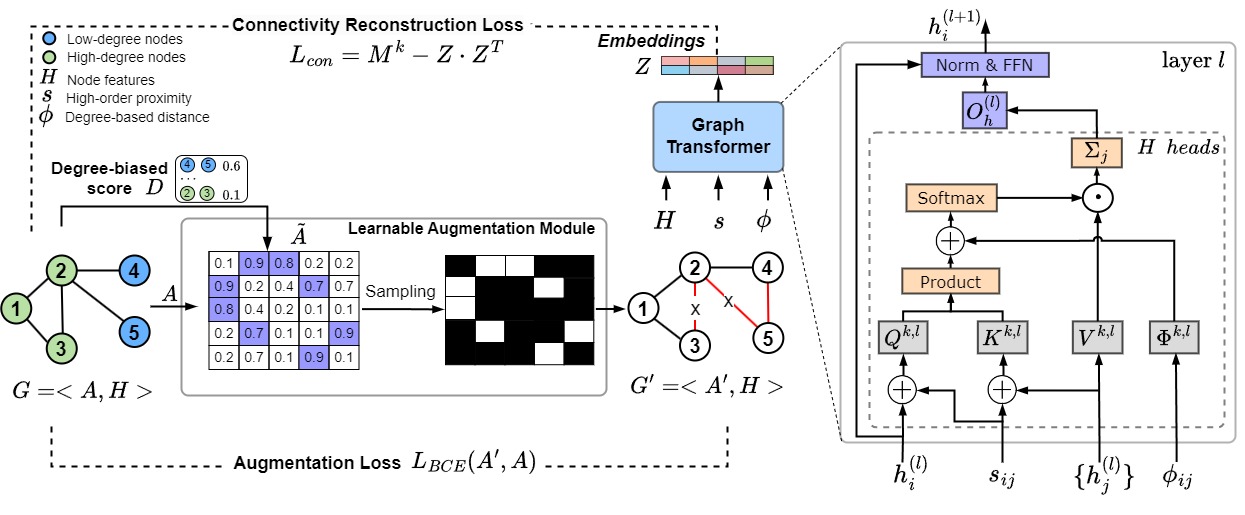We present CGT, a novel Graph Transformer model specialised in mitigating degree biases in Message Passing mechanism and developed by NS Lab, CUK based on pure PyTorch backend.

The overall architecture of Community-aware Graph Transformers.
We utilize community structures to address node degree biases in message-passing (MP) via learnable graph augmentations and novel graph transformers. Recent augmentation-based methods showed that MP neural networks often perform poorly on low-degree nodes, leading to degree biases due to a lack of messages reaching low-degree nodes. Despite their success, most methods use heuristic or uniform random augmentations, which are non-differentiable and may not always generate valuable edges for learning representations. In this paper, we propose Community-aware Graph Transformers, namely CGT, to learn degree-unbiased representations based on learnable augmentations and graph transformers by extracting within community structures. We first design a learnable graph augmentation to generate more within-community edges connecting low-degree nodes through edge perturbation. Second, we propose an improved self-attention to learn underlying proximity and the roles of nodes within the community. Third, we propose a self-supervised learning task that could learn the representations to preserve the global graph structure and regularize the graph augmentations. Extensive experiments on various benchmark datasets showed CGT outperforms state-of-the-art baselines and significantly improves the node degree biases.
A short description of CGT:
- We propose the utilization of within-community structures in learnable augmentations to allow low-degree nodes to be sampled with high probabilities via edge perturbation.
- We propose a novel graph transformer with improved self-attention that takes the augmented graph as input and encodes the within-community proximity into dot product self-attention and the roles of nodes. It is worth noting that we directly encode the high-order proximity into full dot product attention, which could enable CGT to discover the proximity information along with messages from neighborhoods to target nodes.
- We propose a self-supervised learning task to preserve graph connectivity and regularize the augmented graph data to generate the representations.
- Extensive experiments demonstrate that our model outperforms baselines on benchmark datasets and improves degree fairness.
The CGT is available at:
Cite “CGT” as:
Please cite our paper if you find CGT useful in your work:
@Article{hoang2025mitigating_TNSE,
author = {Van Thuy Hoang and Hyeon-Ju Jeon and O-Joun Lee},
journal = {IEEE Transactions on Network Science and Engineering},
title = {Mitigating Degree Bias in Graph Representation Learning with Learnable Structural Augmentation and Structural Self-Attention},
year = {2025},
issn = {2327-4697},
volume = {12},
number = {5},
pages = {3656--3670},
doi = {10.1109/TNSE.2025.3563697},
}
@misc{hoang2025mitigating,
title={Mitigating Degree Bias in Graph Representation Learning with Learnable Structural Augmentation and Structural Self-Attention},
author={Van Thuy Hoang and Hyeon-Ju Jeon and O-Joun Lee},
year={2025},
eprint={2504.15075},
archivePrefix={arXiv},
primaryClass={cs.AI}
}
@misc{hoang2023mitigating,
title={Mitigating Degree Biases in Message Passing Mechanism by Utilizing Community Structures},
author={Van Thuy Hoang and O-Joun Lee},
year={2023},
eprint={2312.16788},
archivePrefix={arXiv},
primaryClass={cs.LG}
}
![]()
![]()
![]()
![]()
![]()





